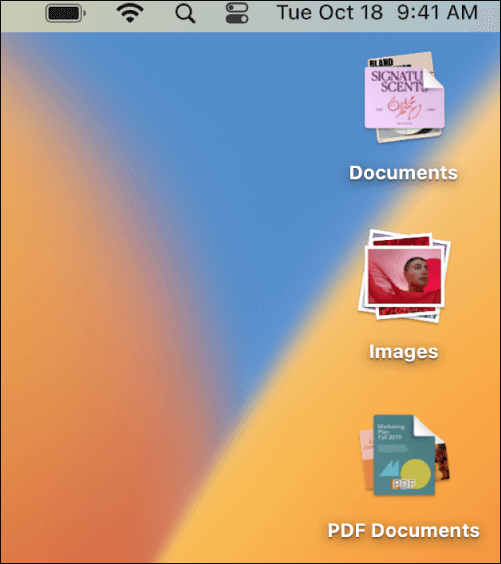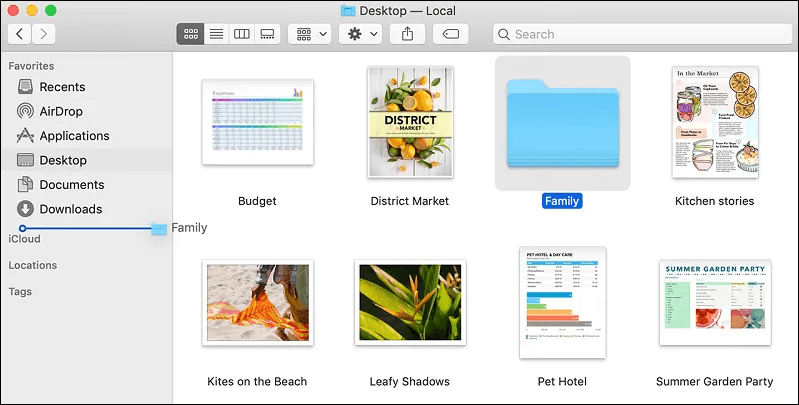Mac Finder: The Default File Manager
Mac Finder came with the first Macintosh computer and was completely rewritten in 2001 when the Mac OS X was released. Its icon is a smiling computer screen implying Happy Mac. And it is named Finder because it is the default file manager that helps you locate and organize files. Check the list below to be more specific about Finder's essential functions.
Mac Finder Functionality and Features
Open windows and files. Switching to the Finder allows you to open a window and see all the files on the Mac. Drag the title bar to move the window; drag the edge to expand the window. Or you can use the buttons in the corner to close, maximize, and minimize the window.
Change the way of displaying files. In Finder windows, the View menu in the view bar or the button at the top allows you to view files differently, such as in a list, in columns, in a gallery, or as icons. Also, you can choose how the files are sorted by kind, date, or size.

Stack the files. Keep the files in neat stacks to make your desktop tidy and clean. It is so convenient that you can locate your files quickly and find exactly the file you want.

Use the Sidebar. The sidebar in Finder windows provides shortcuts for navigating to AirDrop, iCloud Drive, and some frequently used folders.

Search items. The search field in the corner of the window provides a quick way to locate the file you want to open, and the advanced search feature narrows down the search results.

How to Open Mac Finder
Now, you already know some essential functions of Mac Finder. You may ask how to open Mac Finder and where it is, and below is the answer.
Method 1. Through the Dock
Finder is always presented on the dock. To open it, double-click on the icon, and then you can access its features.
Method 2. By Main Menu
Step 1. Place your mouse pointer in a blank space, and click. Don't choose any app or files on the screen. You will see the Finder main menu at the top. Choose "File" and go to "New Tab". A new tab will launch to explore your Mac's storage.

Step 2. A window appears on the screen. On the left panel, you can see the shortcuts.

Method 3. Via Keyboard
Press Command and N to open Mac Finder when you have selected desktop.
Mac Finder Tricks and Tips
Apart from the above essential functions of Mac Finder. What are the other things Finder can do to manage the files better? Here below are some tricks for Mac Finder usage.
Mac Finder Shortcuts
The table below shows you the Mac keyboard shortcuts in Finder so you can quickly access some Finder features.
|
Feature |
Keyboard Shortcut |
|
Open a new Finder window |
Command (⌘) + N |
|
Open a new Finder tab |
Command (⌘) + T |
|
Duplicate the selected file |
Command (⌘) + D |
|
Search for files or folders in Finder |
Command (⌘) + F |
|
Create a new folder in the current location |
Command (⌘) + Shift (⇧) + N |
|
Show or hide the tab bar in Finder |
Command (⌘) + Shift (⇧) + T |
|
Open the Applications folder |
Command (⌘) + Shift (⇧) + A |
|
Open the Utilities folder |
Command (⌘) + Shift (⇧) + U |
|
Open the Downloads folder |
Option (⌥) + Command (⌘) + L |
|
Create a new Smart Folder |
Option (⌥) + Command (⌘) + N |
|
Empty the Trash |
Option (⌥) + Command (⌘) + Delete |
|
Get the icon/list/column/cover flow view |
Command (⌘) + 1/2/3/4 |
Customize Sidebar in Finder
You can select what can be shown on the sidebar. Follow the steps:
Step 1. Click "Finder" from the top menu bar.
Step 2. Go to the "Preferences" option and choose "Sidebar".
Step 3. Check or uncheck the items in the sidebar to decide which item can be shown.

Change Default Finder Window
If you always open Finder and go to the same folder, you can set it as the default Finder window. Here is how you achieve it:
Step 1. Open Finder from the main menu. Go to "Preferences" to open a Finder Preferences window where you can visit the "General" tab.
Step 2. In the "New Finder windows show" section, choose the folder you want to be set as the default Finder window and click on it.

Show Hidden Files via Finder
Some files are hidden, and Apple does this for a reason: to prevent accidental damage to the operating system. Therefore, ensure you know the risks before you do something to these hidden files.
Step 1. Open Finder and click "Go" on the main menu bar.
Step 2. Press the Option key to unhide the files; the hidden files will appear translucent in the folder.

Step 3. Press and hold the Option key while clicking on the library folder and check whether you can find the wanted one.
Rename Multiple Files by Finder
When you have to rename many files, doing them separately is strenuous and time-consuming. Finder supports renaming multiple files at once.
Step 1. Launch Finder and select all the files you want to rename.
Step 2. Click the gear icon on the top bar and choose "Rename…".
Step 3. Then you can decide to replace text, add text, or format, after which you need to add the name and index to each file.

Note: To undo the rename, you can press Command and Z at the same time, or you can go to the menu and choose "Edit" > "Undo Rename".
Fix Mac Finder Not Working
Before going to fix the Mac Finder not working problem, here are some concluded reasons why Finder is not responding:
- Short of storage space.
- Run out of memory.
- Temporary glitches appear in Finder.
- System errors.
- Interference or conflicts from other programs.
- Problematic peripherals.
The article shows you 5 solutions to help you.
Fix 1. Force Quit and Relaunch Finder
When Finder freezes, you should force quit it, and you may have the chance to fix this problem by relaunching Mac Finder.
Step 1. Click the Apple icon and go to "Force Quit Finder".

Step 2. Agree to force quit the Finder in the pop-up window asking if you are sure to force quit.
Step 3. Go to the desktop and right-click on the Finder icon on the dock. From the menu, choose "Relaunch".
There are other methods to stop Finder on Mac. You can check the following passage to stop the Finder action on Mac.
How to Stop Finder Action on Mac in 5 Ways | MacBook Air/Pro/iMac
In some situations, like having difficulty ejecting a disk or closing several Finder windows simultaneously, you might want to stop the Finder action on Mac completely. On the other hand, the Finder does not have a Quit option by default. So how to stop the Finder action on Mac?

Fix 2. Restart Mac
The most straightforward solution to fix Finder not responding or being slow is to restart Mac from the Apple menu, which is a soft restart. Or you can hard restart MacBook or Mac to see if it works.
Fix 3. Check and Clear Storage Space
As said above, being short of storage may cause Finder to freeze or not respond. You can follow the steps to clear storage space.
Step 1. Select "About This Mac" from the Apple menu.
Step 2. Go to "Storage" to check the available space on your Mac.
Step 3. Click the "Manage" button to remove the useless files and applications to have more storage space.
Also, you can choose "Recent Items" from the menu instead of "About This Mac" to clear the recent on Mac.

Fix 4. Uninstall Third-Party Apps
The Mac operation system does not support some applications. Therefore, if you run this kind of app on your Mac, Mac may crash, and first-party apps like Finder cannot respond.
To check whether your third-party apps are the ones that cause the problem or not, uninstall applications on Mac that are recently installed. And then relaunch Mac Finder to see if everything goes well.
Fix 5. Update your Mac
If your Mac runs the previous version of the operating system, there is the possibility that bugs or errors of the old version causes Finder not to respond. Therefore, updating your computer to the latest macOS update is the best solution to fix it.
Step 1. Click the Apple icon, and go to "System Preferences", where you can see "Software Update" and click it.
Step 2. Click "Update Now/Restart Now". Visit "More Info" to check if the version has any updates.
Conclusion
This post gives an elaborate introduction to Mac Finder and step-by-step instructions on how to use it. I hope you better manage your files after reading this article. If you encounter a situation where Mac Finder is not working or responding, you do not need to worry because you can find solutions here.
Mac Finder FAQ
Here are some Finder Related questions to help you know more about Finder.
1. Where is the Finder on my Mac?
You can find Finder on the dock. It opens as you start up your Mac. Finder includes the menu bat at the top of the screen and the desktop below.
2. How do I find my Mac in Finder?
From the Apple menu, choose "System Settings" and click the user's name at the sidebar, after which you can see iCloud on the right side, click it, and you can see "Find My Mac".
3. How do you use Finder on a Mac?
You can check the passage above to find out the usage of Finder. To open Finder, you can click the Finder icon on the dock.
4. How do I open Finder on Mac with the keyboard?
Press Command and F at the same time.
5. What is Finder in Mac equivalent in Windows?
Finder shows all the files and folders on the Mac. It is equivalent to Windows Explorer (File Explorer) in Windows.
Was This Page Helpful?
Daisy is the Senior editor of the writing team for EaseUS. She has been working at EaseUS for over ten years, starting as a technical writer and moving on to being a team leader of the content group. As a professional author for over ten years, she writes a lot to help people overcome their tech troubles.
Related Articles
-
Types of Hard Drives 2025 | Which One to Choose - EaseUS
 Sherly/2025-01-24
Sherly/2025-01-24 -
How to Access Startup Security Utility Mac? [Latest Tips]
 Tracy King/2025-01-24
Tracy King/2025-01-24 -
Windows Command Line Cheat Sheet (Online Table and PDF)
 Daisy/2025-01-24
Daisy/2025-01-24 -
Does Wireless Network Switch Exist? Find the Answer
 Daisy/2025-01-24
Daisy/2025-01-24